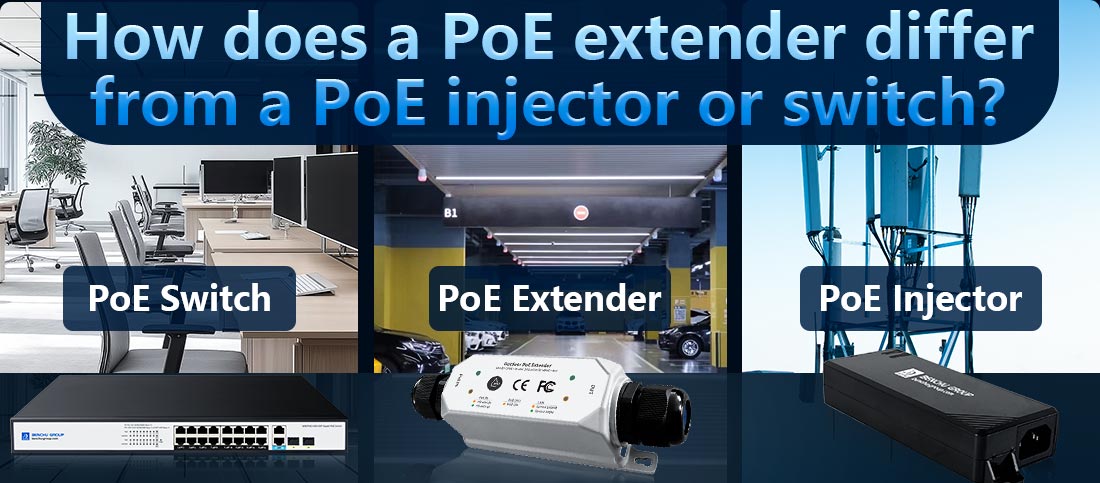
Diferenças entre um extensor PoE, um injetor PoE e um switch PoE
Embora todos os três dispositivos – extensores PoE, injetores PoE e switches PoE – sejam usados em configurações Power over Ethernet (PoE) para fornecer energia e dados por cabos Ethernet, eles atendem a finalidades diferentes e são usados em cenários distintos. Aqui está uma análise detalhada de como eles diferem:
1. Extensor PoE
Propósito
--- Um Extensor PoE estende o alcance da transmissão de energia e de dados além do limite padrão do cabo Ethernet de 100 metros (328 pés). Ele regenera o sinal Ethernet e redistribui a energia para garantir conectividade confiável em longas distâncias.
Características principais
--- Funcionalidade: Amplia o alcance de uma conexão PoE existente em mais 100 metros por extensor. Vários extensores podem ser conectados em cascata para distâncias ainda maiores.
--- Fonte de energia: Recebe energia de uma fonte PoE upstream (por exemplo, injetor ou switch) e a repassa para o dispositivo conectado.
--- Caso de uso: Ideal para instalações que exigem dispositivos habilitados para PoE (por exemplo, câmeras IP, pontos de acesso sem fio) em locais além do limite Ethernet de 100 metros.
--- Cenário de exemplo: Conectando uma câmera de segurança em uma área remota de um grande estacionamento ao interruptor central do edifício.
Vantagens
--- Não há necessidade de tomadas de energia adicionais no local estendido.
--- Compacto e simples de instalar (plug-and-play).
2. Injetor PoE
Propósito
--- Um Injetor PoE adiciona funcionalidade PoE a uma rede não PoE. Ele injeta energia no cabo Ethernet, permitindo transportar energia e dados para dispositivos habilitados para PoE.
Características principais
--- Funcionalidade: Combina energia de uma fonte de alimentação separada com dados de um switch ou roteador não PoE e envia ambos através de um único cabo Ethernet.
--- Fonte de alimentação: Requer conexão a uma tomada elétrica para fornecer energia.
--- Caso de uso: usado quando o switch de rede existente não suporta PoE, mas os dispositivos PoE precisam estar conectados.
--- Cenário de exemplo: Conectando uma câmera IP habilitada para PoE a um roteador não PoE.
Vantagens
--- Solução econômica para redes pequenas que só precisam de PoE em portas específicas.
--- Fornece flexibilidade para modernização de PoE em redes não PoE.
3. Interruptor PoE
Propósito
--- Um Interruptor PoE é um switch de rede com funcionalidade PoE integrada, capaz de fornecer energia e dados para vários dispositivos habilitados para PoE simultaneamente por meio de cabos Ethernet.
Características principais
--- Funcionalidade: Combina os recursos de um switch de rede com recursos PoE, distribuindo energia e dados por várias portas.
--- Fonte de alimentação: consome energia de uma fonte de alimentação externa ou fonte de alimentação integrada, que é distribuída aos dispositivos conectados.
--- Caso de uso: Ideal para redes maiores onde vários dispositivos PoE, como câmeras IP, telefones VoIP ou pontos de acesso sem fio, precisam ser conectados.
--- Cenário de exemplo: Alimentando e conectando um grupo de pontos de acesso sem fio em um escritório comercial.
Vantagens
--- Gerenciamento centralizado de energia e dados para vários dispositivos.
--- Escalável para grandes redes.
Principais diferenças entre dispositivos
| Recurso | Extensor PoE | Injetor PoE | Interruptor PoE |
| Objetivo Primário | Estende energia e dados além de 100 metros. | Adiciona PoE a uma rede não PoE. | Fornece PoE e dados para vários dispositivos. |
| Fonte de energia | Do dispositivo PoE upstream (não é necessária energia local). | Fonte de alimentação externa necessária. | Fonte de alimentação interna ou externa. |
| Caso de uso | Ampliando o alcance do dispositivo PoE. | Adaptação de PoE para redes não PoE. | Distribuição centralizada de energia e dados. |
| Implantação Típica | Locais remotos ou de difícil acesso. | Aplicações PoE de pequena escala. | Grandes redes com vários dispositivos PoE. |
| Número de dispositivos alimentados | Um dispositivo de cada vez. | Um dispositivo de cada vez. | Vários dispositivos simultaneamente. |
Quando usar cada dispositivo
Extensor PoE:
--- Quando dispositivos PoE precisam ser instalados a mais de 100 metros da fonte de rede.
--- Exemplo: Estendendo a conectividade para uma câmera IP remota em um grande armazém.
Injetor PoE:
--- Quando o switch ou roteador de rede existente não possui funcionalidade PoE, mas o PoE é necessário para um único dispositivo.
--- Exemplo: Alimentando um intercomunicador habilitado para PoE conectado a uma rede legada não PoE.
Interruptor PoE:
--- Para soluções centralizadas e escaláveis onde vários dispositivos PoE estão conectados em uma rede.
--- Exemplo: Fornecimento de energia e dados para vários pontos de acesso sem fio em um grande escritório.
Conclusão
Cada dispositivo – extensores, injetores e switches PoE – desempenha uma função exclusiva nas implantações Power over Ethernet. Compreender suas finalidades específicas ajuda a escolher a solução certa com base nos requisitos da rede, no número de dispositivos e nas distâncias envolvidas. Para instalações de longo alcance, os extensores PoE são ideais. Para modernização de redes não PoE, os injetores PoE são econômicos. Para redes escaláveis e centralizadas, os switches PoE oferecem a solução mais eficiente.